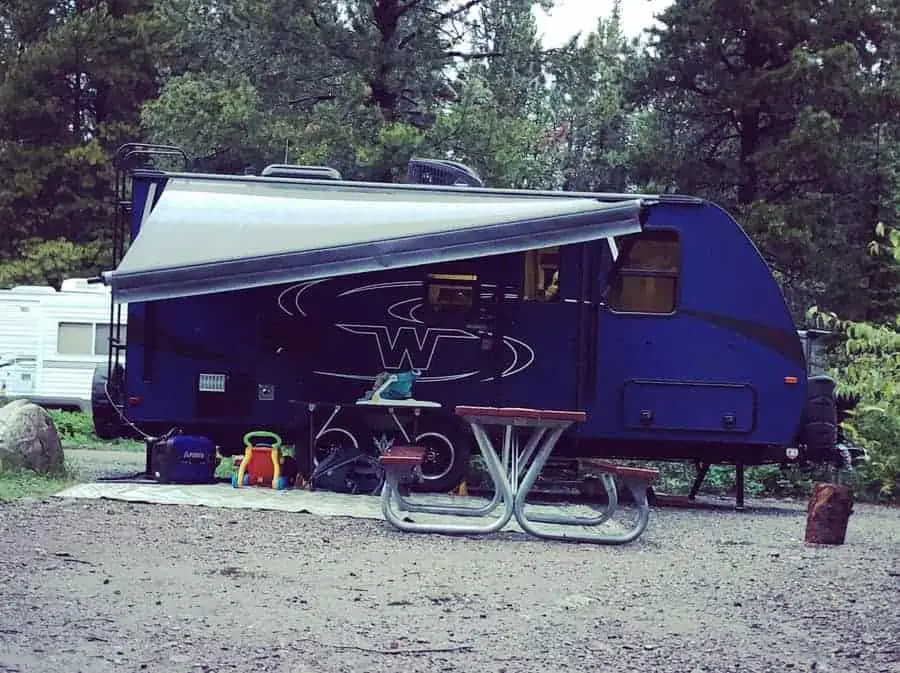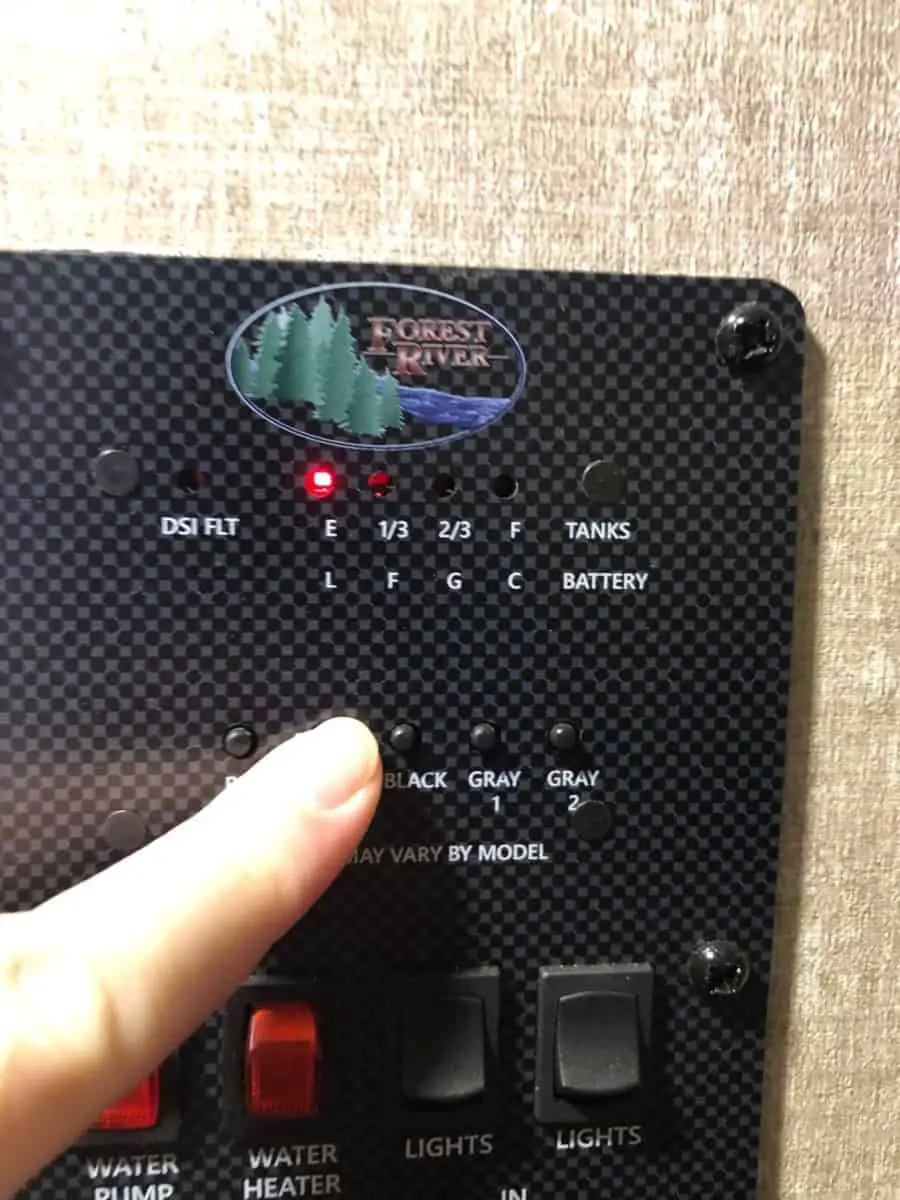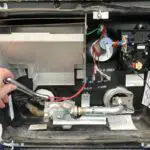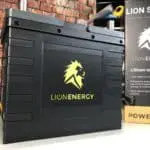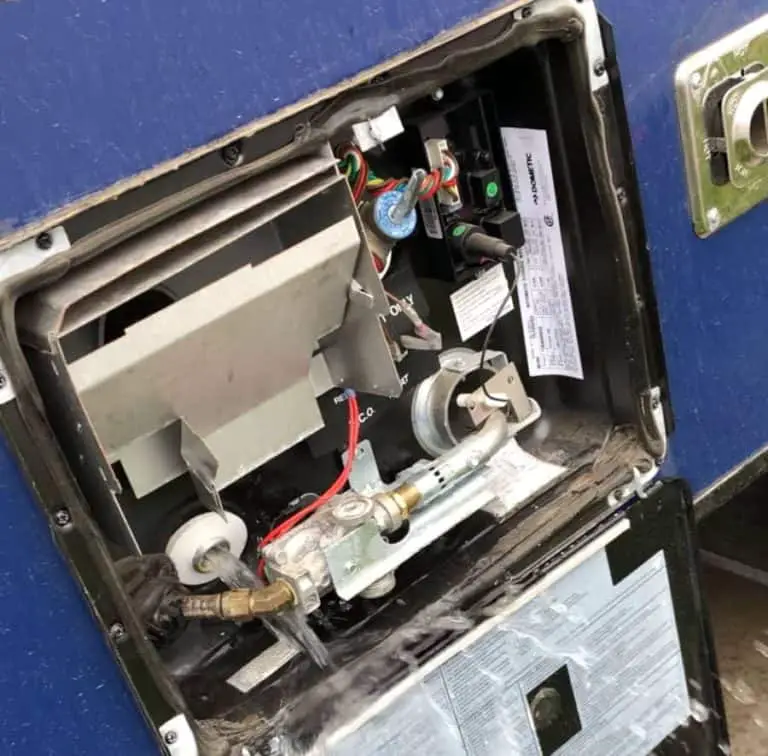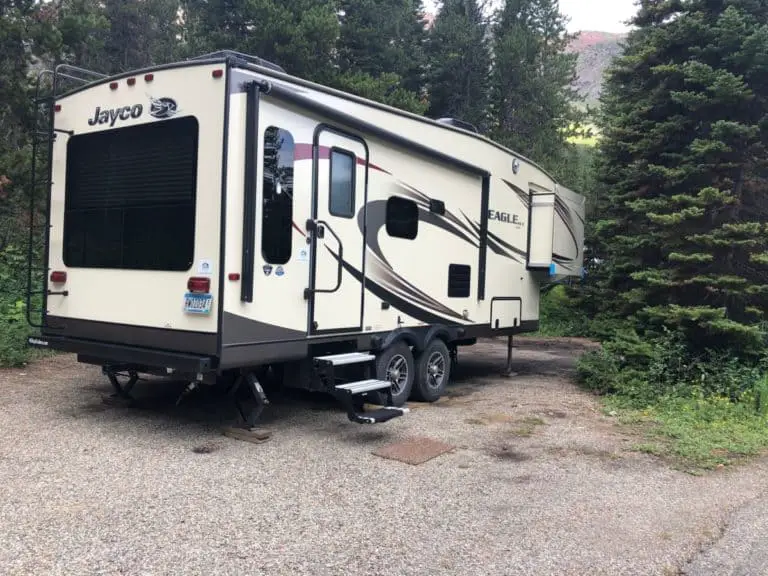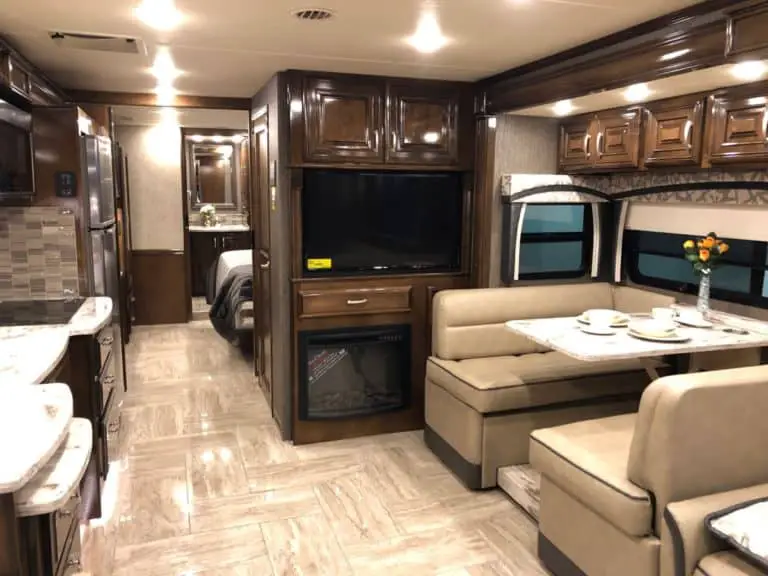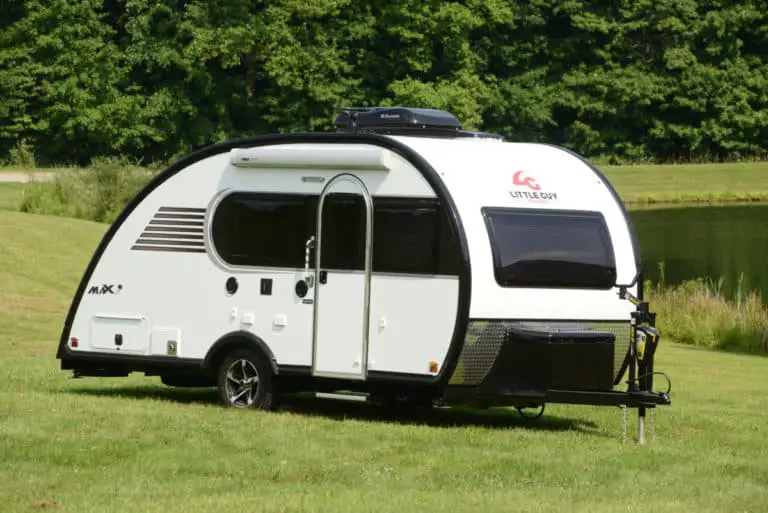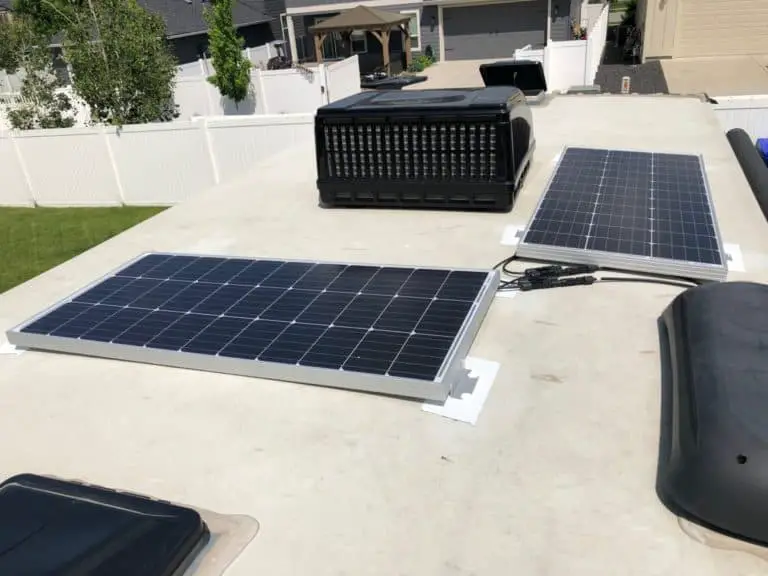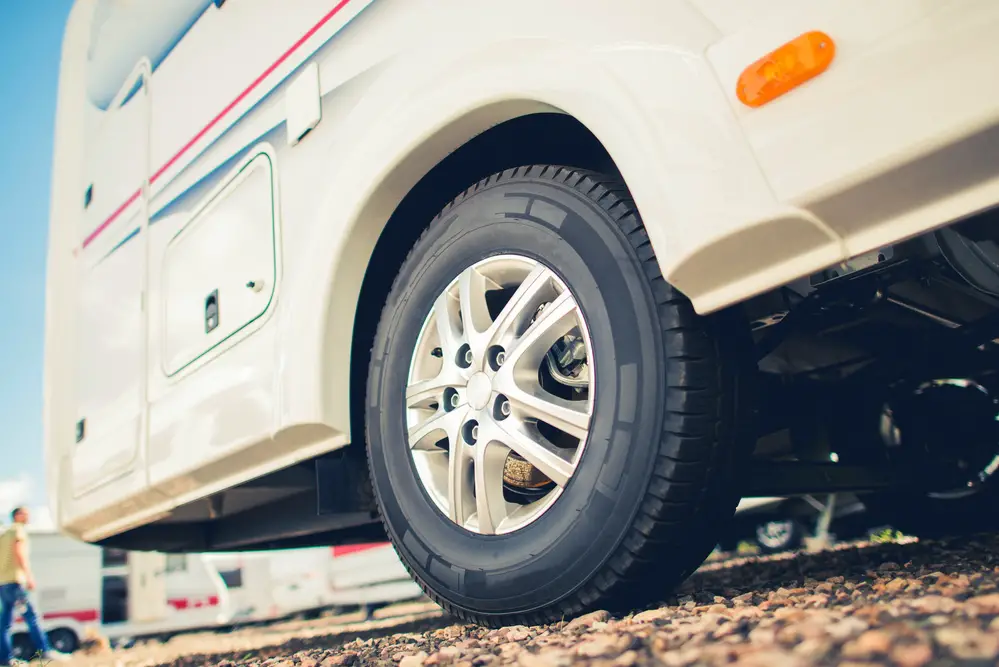How Long Will a RV furnace run on battery? + Handy Calculator Included
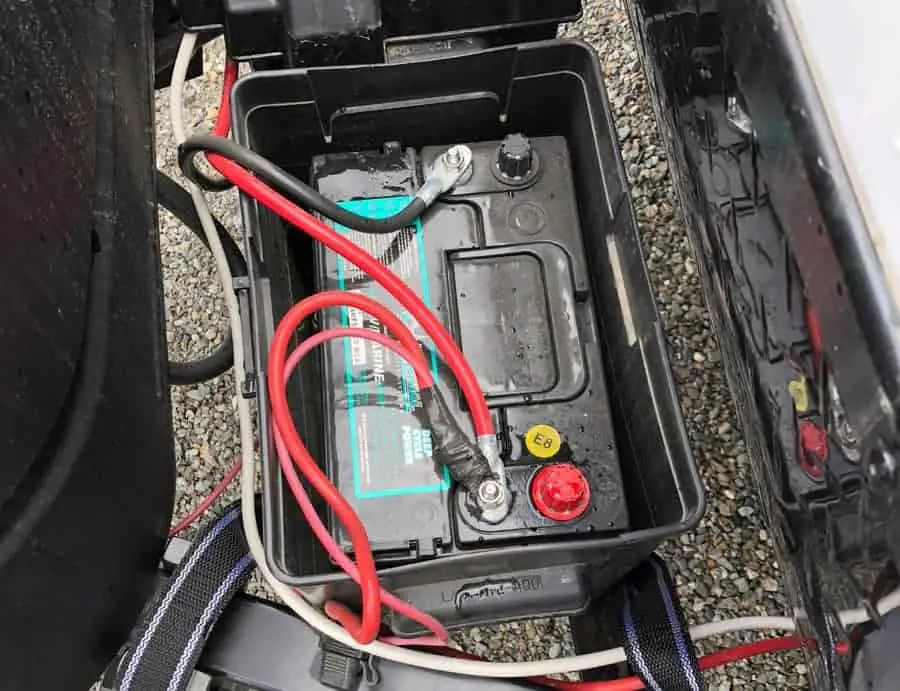
We spend many nights per year in our travel trailer without a connection to shore power. In fact, this is one of our favorite ways to camp. This makes us rely on our preparedness and the systems in the travel trailer that can be run off grid vs the always being plugged in having every comfort of home feeling. RV’ers call this boondocking, and we are a fan, a big one. Our longest boondock trip in the cold season was 9 days. We did however have a generator to keep the batteries topped off as nights were almost freezing and we had a 1 year old infant on the trip. We were able to stay warm and enjoy the early spring weather in Glacier without any worry.
Most RV furnaces will run for a full weekend trip if running on battery, but there are many variations such as battery type, amp hours, furnace size, RV size, insulation, weather, as well as furnace set point that will calculate this. Use our calculator below to find your specific time.
The 12 volt battery system in your RV runs many of your electronics on your Camper, RV, or Travel Trailer. It is easier to explain what it does not run, typically your 12 volt system will not run your a/c, TV, or any other 120 volt plug in items located in your trailer.
The 12 volt system will run the blower on your furnace to allow you to heat your RV while you are off grid. Propane gas is used to fuel the furnace and the 12 volt fan blows the heated air around your coach.
How long Will a 12 volt battery run a RV Furnace?
The furnace in your travel trailer will run without being hooked up to electric as long as you have appropriate battery power. For example, lets say you have 2 12v 100 amp hour batteries providing 200 amp hours. Typically, you are not supposed to draw down over 50% of capacity on lead acid batteries giving you 100 amp hours of usable capacity. A typical blower fan uses 8 amp hours. If there is no other draw on your batteries, you can expect your heater to run continuously for about 12.5 hours.
Even though this looks like a small amount, your heater is never on 100% of the time. Lets say it only runs for 20 minutes every hour to keep your coach heated, it would last 37.88 hours between standby time and running 20 minutes per hour.
This number still may not be accurate as you may set your thermostat back at night, or turn your heat off when you are not in your trailer or off on a hike.
Looking at a third scenario, let’s say you only use the heater at night for 8 hours. Under the same parameters of 20 minutes per hour, your trailer would use 105.6 amp hours over 5 days. Now you can see how this time can be extended greatly. It is almost impossible to calculate how long your batteries will actually last because there are so many variables: outdoor temperature, desired indoor temperature, amp draw of furnace motor, size of RV, insulation used in RV, solar heat gain, etc.
For a good rule of thumb, if you are planning on going camping over 3 days if you have 2 healthy 12 volt batteries, plan on another way to charge your batteries if you are in need of heat such as solar or a generator. Drawing your batteries down past 50% will cause permanent damage.
If you extend your amp hours available in your battery by buying larger 12 volt batteries or upgrading to 2 6 volt batteries, you can gain some additional heating power.
How to Calculate how long a RV Furnace will run on Battery
To determine how long your RV furnace will run on battery, you need to perform a few calculations. This involves determining the power consumption of the furnace and the available power from the battery. Here’s a step-by-step guide:
- Determine Furnace Amperage: Check the specifications for your RV furnace. It should list the current draw in amps (A). The average furnace uses 8 amps. Let’s assume this is (8) amps.
- Battery Capacity: Check the rating on your RV battery. It should be in amp-hours (Ah). Let’s say it’s (100) amp-hours.
- Estimate Realistic Battery Usage: It’s not recommended to completely drain batteries, as this can damage them. For deep-cycle batteries, you might use 50% as a rule of thumb. Thus, if your battery is (100) amp-hours, you have (50) amp-hours of usable capacity.
- Calculate Runtime: Divide the usable battery capacity by the furnace’s current draw to determine how long the furnace can run on battery power:
Battery Capacity/Furnace Amperage Draw= Runtime
For example, if your furnace draws 8 amps and you have a 100 amp-hour lead acid battery (50 usable amp hours), the furnace can run for: 50/8=6.25 Hours
Other Considerations:
- Inefficiencies: Real-world applications often come with inefficiencies, so your actual runtime might be slightly less than the calculated value.
- Other Loads: If other devices or systems (like lights, appliances, etc.) are running off the battery, they will reduce the overall runtime for your furnace.
- Battery Age and Health: As batteries age, they may not hold a charge as well, which can impact runtime.
- Temperature: Cold temperatures can reduce battery efficiency and capacity.
External Factors: Remember that the frequency of the furnace cycling on and off can be influenced by external factors like the outside temperature, the desired inside temperature, insulation of the RV, and more. This means your furnace might not continuously run, so the battery could potentially last longer than the straight calculation suggests.
Remember to monitor the battery voltage while using the furnace to avoid over-discharging and causing damage to the battery. Investing in a good battery monitoring system can provide a more accurate representation of the battery’s state of charge and health.
If you don’t want to do the math the hard way, or have to put in the other items that draw power from your batteries, use the handy calculator below:
RV Furnace Runtime on Battery Calculator
RV Battery Furnace Runtime Calculator
Estimated Runtime: 0 hours
How to use the calculator:
Battery Amp Hours: Enter the amp hours on your batteries. If you have Lead Acid, divide that number by 2 as you can only draw them down to 50%. For example, if you have two 100 amp hour batteries totaling 200 amp hours, only enter 100 amp hours. If you have lithium, enter the full battery amp hours, therefore if you have two 100 amp hour batteries, enter 200.
Furnace Draw Amp Hours: Find the amp hour draw from your furnace or just use the average of 8. Search google for your model number to find this or look in your furnace manual.
Idle Item Amp Hours: This section is for you to enter the other items that are drawing battery such as your refrigerator, smoke detector, carbon detector, lights, pumps, etc… If you don’t know how much draw your items use, use 3 as an average.
Furnace Runtime Per Hour: This is where you estimate how long your furnace runs per hour. Depending on the size of furnace, RV, insulation, outdoor temperature, etc… your furnace will need to run varying times per hour. When the outdoor temperature is in the 40’s our furnace typically runs about 20 minutes per hour. Once you take yours out and measure for an hour, you will be able to estimate your number.
Calculation: The estimated runtime is total time in the trailer, not furnace runtime. If the estimated runtime is 24 hours, that means that your battery will last for a day before it is dead. This is if you left the furnace on the whole time and it ran 20 minutes per hour. There are many other factors that will determine and lengthen this such as: turning the furnace off when you are gone from the RV, turning it off in the daytime, adding insulation to RV vent covers, etc…
In the case study of our travel trailer, if the temperature is in the 40’s, with our two lithium batteries not getting any solar charge, we will expect to be able to heat the RV for 35.29 hours. If we turn this off during the daytime, we can expect to get a 3 day weekend out of the batteries before they are dead.
Our Experience with RV Furnace Runtime in our Travel Trailer
In our experience, if we use our travel trailer in the winter without any charging capabilities, we can get about a three day weekend on two 100 amp hour lithium batteries. Before we upgraded to lithium, we always had to make sure to bring a generator or else our batteries died.
Since then, we have added 200 W of solar on the roof as well as 100 W, portable solar panel, which helps a lot in the winter, but we might not get much solar panel power due to the clouds, but it keeps us going for the weekend. If we stay extended times, we generally have to bring a generator or need plug ins.
RV Battery Types, Capacities, and How Each Type Affects RV Furnace Runtime
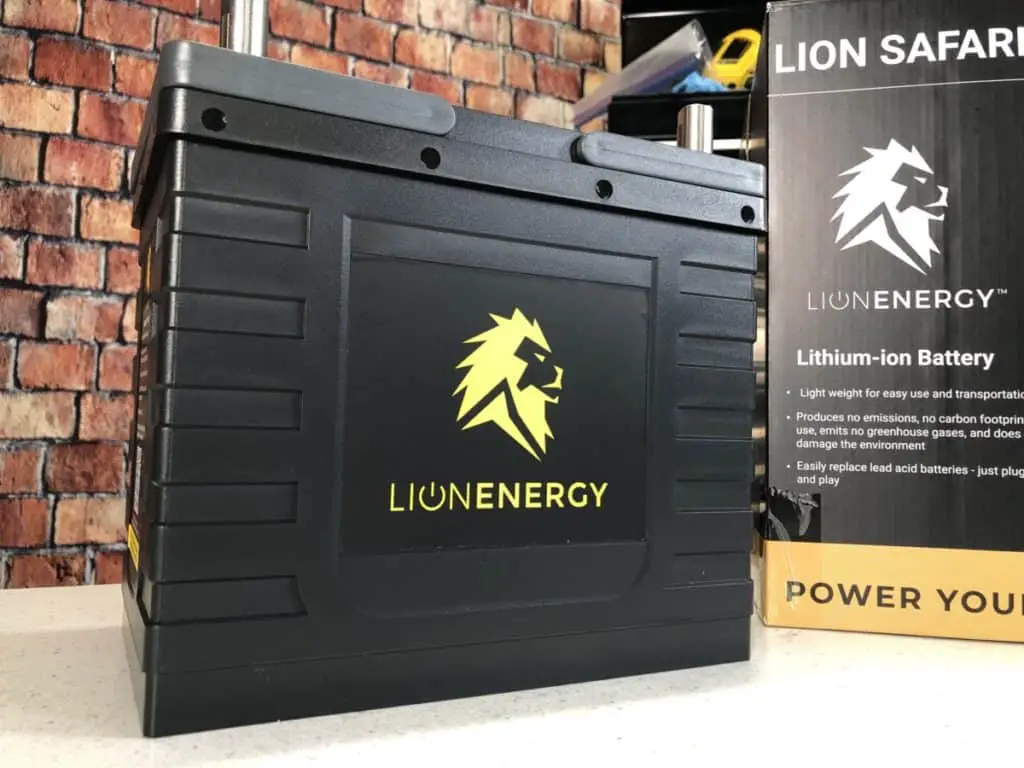
The type of battery you choose for your RV, whether it’s lead-acid or lithium, can significantly affect the runtime of appliances such as a furnace. Here’s how:
1. Capacity:
- Lead-acid batteries: Traditional RVs typically use lead-acid batteries, either in the form of flooded lead-acid (FLA) or sealed variants like Absorbent Glass Mat (AGM) and Gel. These batteries generally have a lower energy density compared to lithium batteries, meaning they store less energy for the same physical size. Most of these batteries are about 100 amp hours on RV’s.
- Lithium batteries: Lithium-ion batteries have a higher energy density, so for a given physical size, they can store more energy than lead-acid batteries. This means you’ll typically get longer runtime with a lithium battery of the same size.
2. Depth of Discharge (DoD):
- Lead-acid batteries: Continuously discharging these batteries deeply (e.g., below 50%) can significantly shorten their lifespan. As a result, RV owners often avoid using the full capacity of their lead-acid batteries to prolong their lifespan. For instance, if you have a 100Ah lead-acid battery, you might only utilize 50Ah of it to avoid deep discharges.
- Lithium batteries: They can typically be discharged more deeply without as significant of an impact on their lifespan. It’s not uncommon for lithium RV batteries to have a DoD of 80% or more. Using the same 100Ah example, this means you could use 80Ah or more before recharging.
3. Voltage Stability:
- Lead-acid batteries: Their voltage drops gradually as they discharge. This can impact the performance of appliances if the voltage gets too low.
- Lithium batteries: They maintain a more stable voltage throughout much of their discharge cycle. This means that appliances like a furnace can operate more efficiently and consistently until the battery is nearly depleted.
4. Weight and Size:
- Lead-acid batteries: They are heavier and bulkier for the same energy capacity compared to lithium batteries.
- Lithium batteries: Being lighter and more compact for the same energy storage makes them a popular upgrade choice for RV owners looking to maximize space and reduce weight.
5. Self-Discharge:
- Lead-acid batteries: They tend to self-discharge at a faster rate when not in use.
- Lithium batteries: They have a much lower self-discharge rate, ensuring more of the stored energy is available when needed.
6. Efficiency:
- Lead-acid batteries: They have lower charging and discharging efficiency compared to lithium batteries. This means that not all the energy used to charge them is available for use.
- Lithium batteries: They boast higher efficiency, so more of the energy stored is available during discharge.
In summary, while both battery types can power an RV furnace, lithium batteries generally offer longer runtime, more efficient operation, and more usable capacity. If you’re running an RV furnace on battery power and seeking the longest possible runtime, lithium batteries are typically the superior choice.
How to heat an RV without propane?
If you do have access to shore power or a generator, always bring along an electric heater to supplement your furnace or even take the place. At night you may need to just run a small electric heater in your bedroom to keep one area of the trailer heated and not run the whole furnace wasting propane on unnecessary spaces.
When we are boondocking and we need to charge our batteries, we plug the heater in to gain some heat without using propane. This is better than using propane as the generator does not charge the batteries at as high of a rate as the motor on the furnace will use. Obviously, we will use more fuel on the generator by working it harder, but not by much.
If you position your RV to get direct sunlight in the fall, winter, and spring, you can take advantage of natural light to help heat your RV as well as provide free lighting within. In the summer, you would want to do the opposite and avoid natural light to keep the heat out of your rig.
10 Tips to Make your Furnace last Longer when Running on Battery
There are several ways to make your heating power last longer when you are boondocking or not connected to shore power. This ranges from easy items such as turning your heat down to more expensive items such as installing solar.
Set your Thermostat Back at Night
Typically sleeping in a cooler environment provides a better sleep, also while sleeping you gain warmth from blankets or sleeping bags while camping. Try setting your thermostat back at night to whatever you feel comfortable with in order to save battery power.
Turn your Heat off when not in trailer
While you are off on an adventure, make sure you turn your heater and other devices off as to not use battery power when you are gone.
Buy Higher Amp Hour Batteries
Higher amp hour batteries will tend to last longer than cheap batteries you that come with your RV or that you can buy over the counter at a parts store. Here are our top high amp hour batteries compared.
Manually turn your thermostat on when you need heat and off when you are up to temperature
Your body may feel heated, but your thermostat may say it is time for heat. When we really want to save battery power from running our heater, we manually turn the heater on to heat up the RV, after it is heated, we manually turn it off. This keeps the heater from cycling when we are still feeling warm in our trailer as to not keep heating unnecessarily when we are actually warm for the time being.
Make sure your Ductwork connected properly
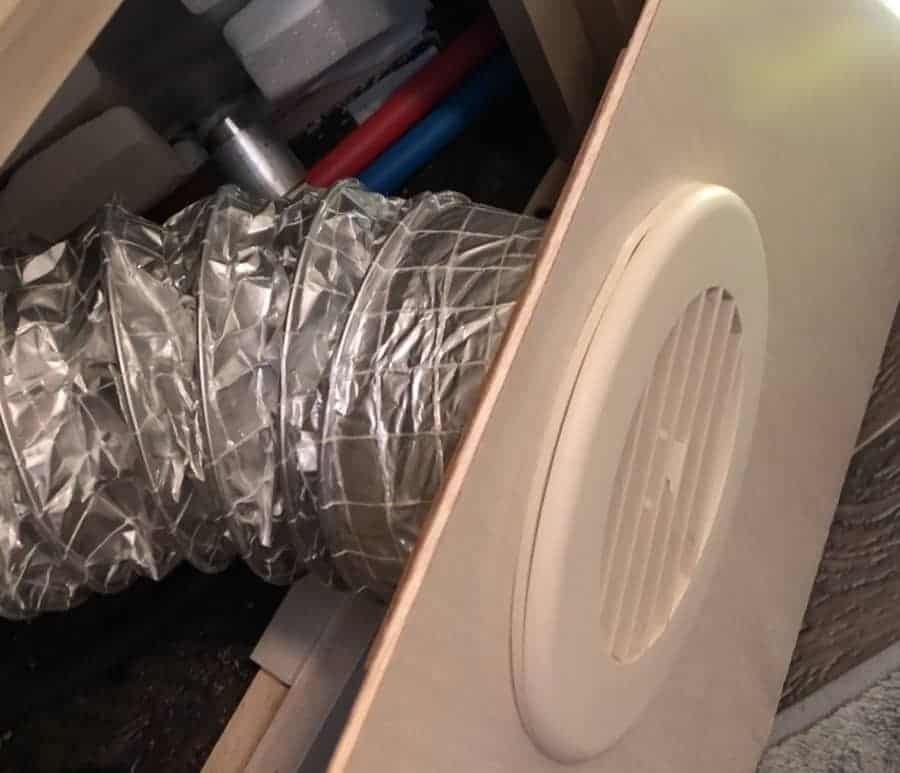
While winterizing our RV, we found out one of our heating ducts was not actually hooked up. Here is an after picture of hooking it up to the louvers. We were getting heat out of the unit, but it was also circulating heat behind our cabinets and water heater first. If you want to install an additional duct, follow our how to guide.
Layer up
Always make sure to wear multiple layers so you are warm and can dial back the thermostat to keep your heater usage down as much as possible.
Position RV to get maximum direct sunlight
You would be surprised on how much heat you can get even in the winter if you are positioned in direct sunlight. We recently visited our RV in storage in February when the temperature was about 45 and sunny, and the RV was surprisingly warm.
Insulate areas in your RV
There may be areas where the factory skimped on insulation on your RV, we have found a few areas ourselves in our trailer such as the floor on the slide out or under the folding part on our murphy bed which goes into the passthrough storage. We purchased some closed cell foam insulation to add to keep our heat in and the cold out. Also, insulating your vent covers will keep a lot of heat in.
Install Solar to keep your batteries charged
Keeping your batteries topped off can be accomplished with some rooftop or suitcase solar. If you have about 200 watts solar, you may start off the morning recharging your batteries at 2-3 amp hours and in the afternoon you may see 4-5 depending on the sun. If your fan uses 8 amp hours and you use it for 2 hours per day, you may need 4 hours of sunlight to recharge it depending on the conditions. We installed this solar kit and it has worked great! If you want to learn more about solar, read our guide on how much you will need.
Bring a generator to keep batteries charged
We use our generator to keep our batteries topped off when we are out boondocking. Typically we have to run it 1-2 hours using the onboard charger to fill up our batteries per day. We camp in popular campgrounds and like to enjoy the quiet outdoors, so we plan on upgrading to solar to get rid of the constant generator sound. We have a 2,000 watt generator that powers everything we need besides the a/c. Learn more about the top generators we recommend.
More ways to stay heated in the winter.
If you are still looking for ways to stay heated, read our post on the top tips to keep warm in your RV or travel trailer in the winter.
Are RV Furnaces Gas or Electric?
RV furnaces are propane gas powered which is supplied by electric to run the fan to blow the hot air around. The only electric heat in a camper would be either from a heat pump, heat strip in your a/c unit, or from a plug in electric heater.
If buying a new RV, it will most likely come with a ducted furnace that uses both propane gas and electricity. A ducted furnace is similar to the A/C system in your house. There is a control panel that controls the heat and air. The air flows through air vents located on the floor and/or ceiling. The propane heats the furnace while the electricity turns on the furnace and makes the fan move to circulate the heat. There are many benefits to this type of furnace. It warms the entire RV quickly and the basement part of the RV. This is beneficial because, on cold nights, the furnace will prevent the water and sewer hook-ups and pipes from freezing.
Another benefit is that this type of furnace has an external vent, so that moisture does not build-up within the cabin. One downside to this furnace is that it uses a lot of propane. If you run out of propane the furnace will not work, even though it’s hooked up to electricity.
Tip: Always run on one propane tank if you have dual tanks instead of both. Therefore, if you run out in the middle of the night you can switch the tank over on the regulator and get propane in the morning. If you pull from both tanks, when you run out you will not have any reserve propane to keep you heated until you can refill.
If you have an older RV, then you most likely have a non-ducted furnace. This is an older style of furnace. This furnace isn’t as efficient as the newer ones and just run propane. They really use up propane. There is no central control panel or floor/ceiling vents. There is only one square vent that supplies heat to the entire cabin. Generally, these have a more difficult time heating the entire RV, especially if it is large. Also, if you have a custom-built RV with no A/C or heat system, then you can have a non-ducted furnace installed.
It is recommended for furnaces to be serviced once a year. You will need to take the RV to a mechanic and not service it yourself. Furnaces can be dangerous since you are dealing with gas and electricity, you have to be cautious so they do not catch fire or explode.
Do RV furnaces have filters?
All furnaces, ducted and non-ducted, do not have filters. Since these furnaces run on propane, and some with both propane and electric, there is no filter because it could catch fire. You need to keep all ducts clean for the air to flow and to prevent over-heating.
To keep the ducts clean, you must make sure items are not covering the floor and/or ceiling vents. Many people put a trash can in front of a wall vent or the return vent unknowingly, it must be moved. Also, check the outside vent to make sure nothing is blocking it and clean it periodically. Many times, bugs or spiders like sit in this vent.
If a spider gets in this vent, they will spin a web that blocks the air from venting. This could also create a potential fire or cause the propane to release back into the cabin of the RV. If you ever smell the propane, shut the propane valve off immediately. This could mean that there is a leak somewhere or a blockage. This is very dangerous and could create a fire, an explosion, or cause dire health risks. A good tip is to purchase a carbon monoxide detector for the cabin.
Another good tip is to vacuum all vent covers inside the cabin, i.e. the vents on the floor and ceiling. By vacuuming, it will remove all dust build-up, hair build-up (especially if you have a dog or cat with you), or anything that could be blocking the ventilation.
Also, it is a good idea to vacuum around the furnace itself. The vent cover that hides the unit is easy to remove. Once removed, vacuum around the unit but be careful to not disturb the unit. There is most likely the same dust and hair build-up around the unit like what is in the cabin vents.
If you would like to have your furnace pulled out, checked, and deep cleaned, always take it to a licensed technician. As said previously, they can be dangerous if handled improperly.
Frequently Asked Questions:
Will a RV furnace run on battery?
Yes, the furnace will run on batteries. Heat is actually produced from propane, but the blower fan runs on battery. The typical furnace will draw about 8 amps of power. It is a good idea to have solar or generator power to supplement the charging of your batteries when not connected to shore power.
Do RV furnaces run on electricity?
Yes, RV furnaces will run while you are plugged into electric. Your furnace will still run off of your 12 volt power, but your batteries will be charged from your on board charger. If you do have access to electricity, it may be a better benefit to invest in a small heater like the one we recommend on our page about how to keep your RV heated in the winter.
What is the best electric heater for a RV?
We prefer an electric heater that uses a fan to circulate the air in your trailer. Another important feature is to find a heater with a thermostat and not just high, medium, and low settings. You may wake up with the RV too hot as it is not self controlling. We like this model as it fits our criteria.
Is one 12v battery enough to power a RV furnace?
Yes, 1 12v battery would be enough to power an RV furnace, but it would be better to have two. If your one battery has 100 amp hours, you can safely draw it down to 50% or 50 amp-hours. This would give your RV 6.25 hours of heater runtime without any other draws to spread over the days of your trip.
Helpful Products Mentioned in this Article:
An electric heater with a thermostat will work wonders by giving you constant heat while plugged in at a campsite.
Upgrading to Lithium Batteries will extend the time you can run your heater as they have much more usable capacity than Lead Acid. They also run better in the cold than Lead Acid. 1 Lion Energy UT1300 will give you more power than two 100 amp-hour Lead Acid batteries.
Insulating your vents will provide a lot more heat retention as they are cheap plastic with no insulation factor.
A solar kit like our favorite here will keep your batteries charged in the winter giving you peace of mind that you will not run out of battery.
If you are not into solar, a generator that is remote start can greatly improve your cold-weather camping. You can start it in the morning to make your coffee without stepping foot outside in the cold!
Be the first to be notified about FREE tips, hints, coupon codes, and email-exclusive information. All for FREE!


